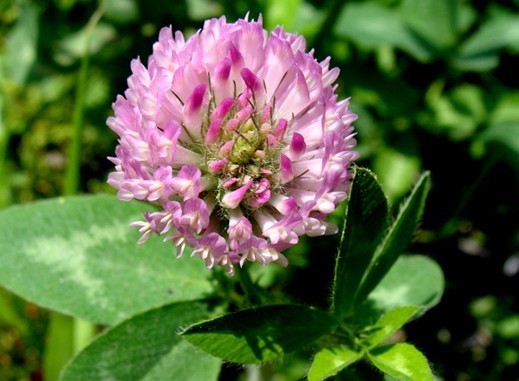Natural Products
Trifolium pratense L.
Native to north Atlantic and central Europe, the Mediterranean region, Balkans, Asia Minor, Iran, India, Himalayas, Russia from Arctic south to east Siberia, Caucasus, and the Far East. It spread to England ca 1650 and was carried to America by British colonists.
Extensively grown for pasturage, hay and green manure, considered excellent forage for livestock and poultry. Compared with alfalfa, red clover has about two-thirds as much digestible protein, slightly more total digestible nutrients, and slightly higher net energy value. The best approximation to vegetable boullion I ever made consisted of red clover and chicory flowers, boiled vigorously with wild onion and chives. Red-clover flowers are reported to possess antispasmodic, estrogenic, and expectorant properties.
Through LC-MS comparative studies on the plant extracts, 20 flavonoid glycoside malonates were detected in the flower extract. The study also found that the flowers contained flavones as the major flavonoids, whereas the leaves had isoflavones as the major flavonoids.
Extensively grown for pasturage, hay and green manure, considered excellent forage for livestock and poultry. Compared with alfalfa, red clover has about two-thirds as much digestible protein, slightly more total digestible nutrients, and slightly higher net energy value. The best approximation to vegetable boullion I ever made consisted of red clover and chicory flowers, boiled vigorously with wild onion and chives. Red-clover flowers are reported to possess antispasmodic, estrogenic, and expectorant properties.
Through LC-MS comparative studies on the plant extracts, 20 flavonoid glycoside malonates were detected in the flower extract. The study also found that the flowers contained flavones as the major flavonoids, whereas the leaves had isoflavones as the major flavonoids.
Research products of Trifolium pratense L.
| Catalog | Product Name | CAS Number | Manual |
|---|---|---|---|
| CFN99734 | Biochanin A | 491-80-5 | |
| CFN98681 | Genistein | 446-72-0 | |
| CFN90250 | Genistin | 529-59-9 | |
| CFN98774 | Daidzein | 486-66-8 | |
| CFN99101 | Daidzin | 552-66-9 | |
| CFN98117 | Beta-Carotene | 7235-40-7 | |
| CFN98735 | Isorhamnetin | 480-19-3 | |
| CFN98794 | trans-4-Hydroxycinnamic acid | 501-98-4 | |
| CFN97005 | Sissotrin | 5928-26-7 | n/a |
| CFN97016 | Isosativan | 60102-29-6 | n/a |
| CFN93803 | 4-O-beta-Glucopyranosyl-cis-coumaric acid | 117405-48-8 | n/a |
Screening Libraries
Glycyrrhiza uralensis Fisch.
A unique collection of 50 natural compounds from Glycyrrhiza uralensis Fisch.
A unique collection of 50 natural compounds from Glycyrrhiza uralensis Fisch.
Platycladus orientalis
A unique collection of 25 natural compounds from Platycladus orientalis
A unique collection of 25 natural compounds from Platycladus orientalis
Derris robusta
A unique collection of 22 natural compounds from Derris robusta
A unique collection of 22 natural compounds from Derris robusta
Catharanthus roseus (L.) Don
A unique collection of 34 natural compounds from Catharanthus roseus (L.) Don
A unique collection of 34 natural compounds from Catharanthus roseus (L.) Don
Tamarix chinensis Lour
A unique collection of 22 natural compounds from Tamarix chinensis Lour
A unique collection of 22 natural compounds from Tamarix chinensis Lour





